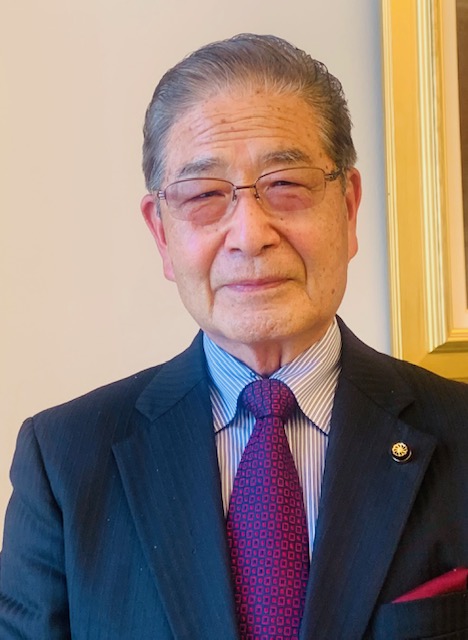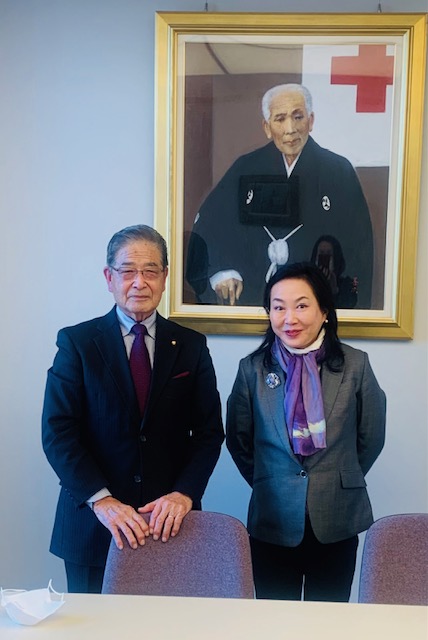PEOPLE
Former Director of the Sano Tsunetami Memorial Museum (currently known as Sano Tsunetami and the Mietsu Naval Dock History Museum)

After Some Twists and Turns, It Was Selected as One of the Component Parts.
Kato: Actually, before that, there was some trouble. Mr. Smith suggested that if we dug up the gate ball field and parking lot, something might come out, and I asked the Agency for Cultural Affairs to dig them up. Still, the prefecture and city were vehemently opposed because the Ariake Engan Road might pass through. This probably made the Agency for Cultural Affairs reluctant because they were worried about what they would do if they went that far and found nothing. More to the point, I think the Agency for Cultural Affairs was skeptical about whether Saga would remain on the provisional list of Heritage of Industrial Revolution.
Eguchi: I see.
Kato: Even if foreign World Heritage specialists came and conducted excavation work, it would not be easy. Instead, the Agency for Cultural Affairs wanted to focus on the end of the Tokugawa Shogunate and take up the challenge in the form of a theory of iron manufacture at the end of the Tokugawa Shogunate, which is Mr Suzuki's specialty. We told them that we would not interfere with the Ariake Engan Road and wanted their cooperation in leaving Saga on the provisional list; however, the influence of National Road was more substantial, so we were left with no choice. In response, Mr. Haji started campaigning furiously, and the Agency for Cultural Affairs finally moved.
Eguchi: At that point, I had retired as mayor of the town, but during my tenure, I was researching the Mietsu Naval Station site from the perspective of tourism. That was when I asked the prefecture to put in trenches, and thus, we were able to excavate some of the sites. That didn't lead to anything, but that is what happened. And then there was the fact that the research continued after that, and I think that is why the Agency for Cultural Affairs was leaning towards the direction that the possibility was not necessarily zero.
Kato: I think so. It was also significant that you were a man of great enthusiasm and had established the Sano Tsunetami Memorial Museum during your term as mayor. If there had been no Sano Tsunetami Memorial Museum, we would have been hopeless. In the first place, we could not have reached the ruins of the Mietsu Naval Station. We started simply by deciding to visit the Sano Tsunetami Memorial Museum since it was there. By the way, what was the reaction of the citizens?
Eguchi: There was a feeling that although the Mietsu Naval Station Site might become a national historic site (it was designated as a national historic site in 2013), it would be too far-fetched to call it a World Heritage Site. As soon as I started talking about “if the Mietsu Naval Station Ruins are registered as a World Heritage Site…” everyone smiled grimly (laughs).
Kato: You, Mr. Eguchi worked energetically.
Eguchi: First, three local forums and symposia were held, and four Kids History Rams were held at Saga University; in 2009, PR citizens’ activities for the Mietsu Naval Station site were launched; and in 2011, through the conservation activities of 80 major organizations in the local areas of the Mietsu Naval Station Site—namely Kawazoe Town and Morotomi Town—, the administration and organizations by citizens were set up. Amid positive efforts, I had a nightmare that only Saga was off the list, and I could not help myself from calling you to ask, "If Saga was really ok?"
Kato: Even for me, I was fighting against the pressure of having so many people involved, so I understand. In fact, I was in a pinch. Even among the committee members, there were two opinions: some thought this would pass, and others thought it wasn't good enough. The biggest problem was that we felt that it was after the steamboat was built, but the excavations left no traces of a steamboat. They say that when a steam engine is used, the soil in the area is discoloured by the heat, but they did not find any discoloured soil.
Eguchi: We heard that the masonry furnace had changed colour in some parts, and that came out, but overall, it was not very conclusive, and there were some tense moments.
Kato: But even if it was a wooden dock, docks that made good use of river currents are rare in Japan and are extremely valuable relics. And the fact that the Mietsu Naval Station was a pioneer in training for the operation of large vessels and in preparing the facilities for further ship repairs... It is a fact that the Mietsu Naval Station was a pioneer in the field of training for the operation of large ships and the establishment of facilities for the repair of vessels. At the same time, however, there are still some dream-like, or rather slightly over-advanced, illustrations that can be found....... For example, there are no blast furnaces in Saga. The reason is that iron cannot be extracted in Saga, but there are drawings that have been left behind that assume that iron could be extracted, which lacks credibility. It was once pointed out that it would be difficult to register the site without clarifying where and to what extent it was factual. In this situation, the researchers from Saga City were excellent and were able to provide us with persuasive material.
Eguchi: Yes. The foreign experts were surprised when we finally unearthed a Western-style dry dock on the riverbed. Morotomi Town and Kawazoe Town merged with Yamato Town, Fuji Town and Mitsuse Village in 2005 to form the new Saga City, but it would have been difficult for them to unite after the merger. In this sense, the timing was good. Above all, despite some tense moments, the talks generally progressed speedily. I can now clearly see that this was due to the power of you, Ms Kato and that we were driven forward by your passion and conviction.
Kato: Thank you very much.
Eguchi: The Mietsu Naval Station Site, which has been registered as a World Heritage Site, must be managed and preserved for the next 100 years or even through all eternity. It was our generation that was involved in the World Heritage registration, but the big challenge is to pass on the passion of our generation to the next generation. As part of school education, I would like to devote my efforts to conveying to children the history of the end of the Edo period, the history of modernization and the history of the Mietsu Naval Station.
Kato: We look forward to continuously working with you in the future.

Former General Manager, Nagasaki Shipyard and Machinery Works, Mitsubishi Heavy Industries, Ltd.
Chairman, Fujisankei Group
Executive Managing Advisor, Fuji Television Network, Inc.
Executive Managing Advisor, Fuji Media Holdings, Inc.
Advisor, Federation of Japan Port and Airport Construction Association
(Ex. Chairman of Specialists Center of Port and Airport Engineering)
Mayor of Nagasaki City
Former Director of the Sano Tsunetami Memorial Museum (currently known as Sano Tsunetami and the Mietsu Naval Dock History Museum)
Director of NPO Association for Thinking about Satoyama
Director of National Congress of the Industrial Heritage
Honorary Chief Priest Toshinari Ueda
Former Mayor of Omuta City
Archaeologist and Heritage Conservation Specialist
A fellow of the Japan Federation of Engineering Societies
Team Member of the Industrial Project Team Office for the Promotion of World Heritage Listing under Cabinet Secretariat
Governor of Kagoshima Prefecture
Mayor of Hagi City
Mayor of Uki City, Kumamoto Prefecture
The Former Employee of Nippon Steel Corporation
An Associate Professor of the Faculty of Science and Engineering in Iwate University
Chairman of the Tourist Guide Association of Misumi West Port
President of Kuraya Narusawa Co., Ltd.
Chairman of Izunokuni City Tourism Association
Director and General Manager of Gunkanjima Concierge
Producer of the Gunkanjima Digital Museum
Owner at Tōge Chaya
Chairman: Mr. Hidenori Date
President: Mr. Masahiro Date
Proprietor, Houraikan Inn
Representative Director of Egawa Bunko non-profit incorporated foundation
The 42nd head of the Egawa Family
Democratic Party for the People (DPP) Representative for Nagasaki Prefecture
President of the NPO, Way to World Heritage Gunkanjima
Representative Director
MI Consulting Group
President of Watanabe Production Group and Honorary Chair of Watanabe Productions Co., Ltd.
Member of the House of Councillors
Governor
Kagoshima Prefecture
World Heritage Consultant
Director and Dean, The Kyushu-Asia Institute of Leadership
Representative Director, SUMIDA, Inc.
Journalist, founder of the Shimomura Mitsuko Ikikata Juku School
Representative, Rally Nippon
Chairman, Sites of Japan’s Meiji Industrial Revolution World Heritage Route Promotion Council Director, National Congress of Industrial Heritage
Representative Director, General Incorporated Foundation National Congress of Industrial Heritage (Advisor, Public Interest Incorporated Foundation Capital Markets Research Institute)
Mayor of Nagasaki City
Policy Director at Heritage Montreal
World Heritage Consultant
Executive Director of Kogakuin University
Heritage Architect and International Consultant
Head of Data Acquisition at The Glasgow School of Art’s School of Simulation and Visualisation
Head of Industrial Heritage, Historic Environment Scotland, Edinburgh
Scottish Ten Project Manager, Historic Environment Scotland, Edinburgh
Mayor of Izunokuni City, Shizuoka Prefecture
Pro-Provost and Chairman of Council of the Royal College of Art. Heritage advisor of Canal & River Trust for England and Wales.
Dean of Tokyo Rissho Junior College
Professor emeritus of Keio University
Mayor of Kitakyushu City
At the 39th session of the World Heritage Committee convened in Bonn, Germany, from June 28 to July 8, 2015, the decision was approved to inscribe the Sites of Japan’s Meiji Industrial Revolution on the World Heritage list.
At a celebratory party held to mark the occasion, some of the primary promoters of the project spoke of their joy in achieving their goal and of the trials and tribulations to getting there.
Director and Managing Executive Officer, Hanshin Expressway Company Limited
Member, Board of Directors, National Congress of Industrial Heritage
Vice-Governor of Shizuoka Prefecture
Mayor of Hagi City
Chairman, Tokyo Metro Co., Ltd.
Mayor of Omuta City
Deputy Director-General, Lifelong Learning Policy Bureau, MEXT
Former Counsellor, Cabinet Secretariat
Mayor of Kamaishi City
Member, Board of Directors, National Congress of Industrial Heritage Counselor, Shimadzu Limited
Chairman of the Consortium for the World Heritage Inscription of Modern Industrial Heritage (Kyushu-Yamaguchi) and governor of Kagoshima Prefecture (as of 2015)